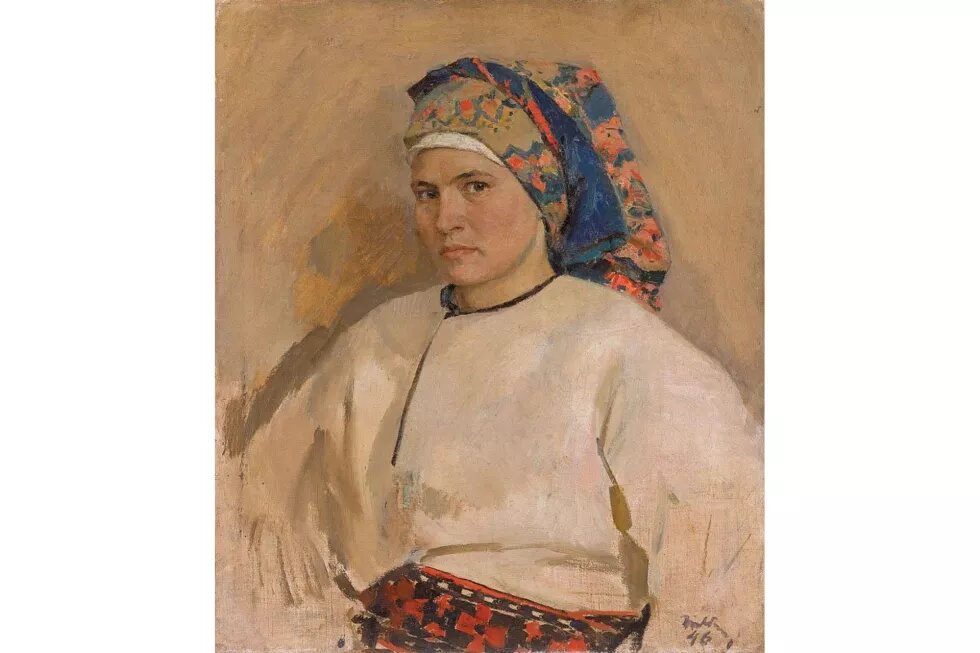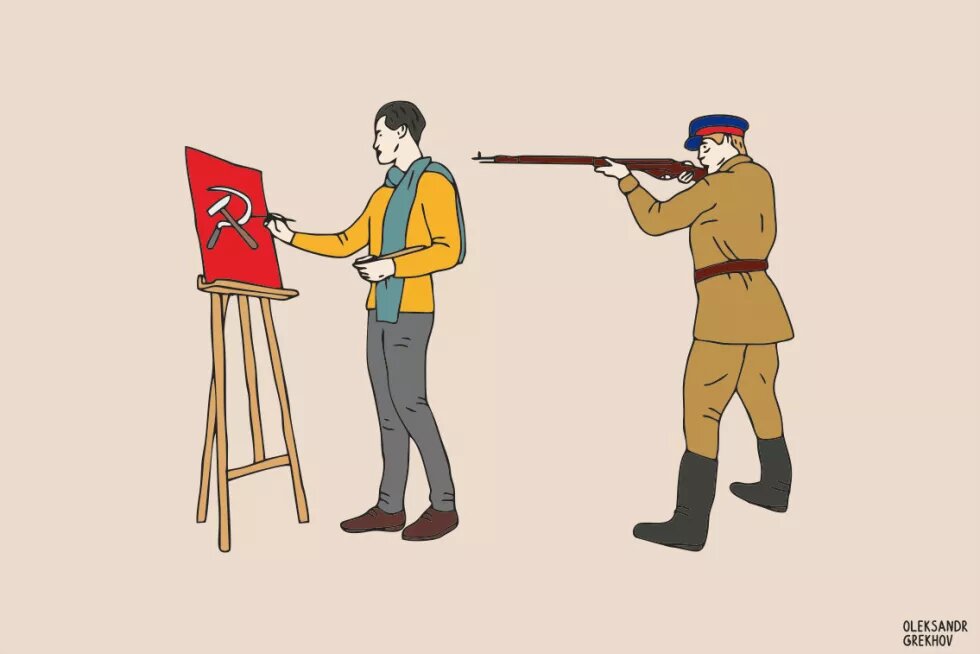
Art historian Illia Levchenko talks about how colonial Russia unified local culture by destroying it.

If asked to name colonialism’s dominant trait, I’d say it is unification. An empire is a patchwork, with each piece having its distinct cultural, political, and administrative features and mindset. A colonial repressive mechanism promotes the illusion of a homogeneous space where everything is common: the language, the cultural norms, the traditions. Every feature, once forced upon a given group of people, must be taken by that group as something primordial and familiar. Such commonality is always composed of asymmetrical parts: there is the centre (the high culture), and there is the periphery (uncivilized, underdeveloped, profane culture) to be assimilated by that centre. The rhetoric of the process is soaked with cynicism: what is actually an eradication of local peculiarities is presented as some important emancipatory factor, the one opening the way for that periphery to be upgraded to turn the periphery into a full-fledged part of the centre. Such common space is created through both repressive mechanisms and through agents with a hybrid identity. Possessing both identities, those agents are equally seen as “one of our own” by both the colony and the metropolis. Given the effective use of such soft power, hostilities are either unnecessary or avoided as much as possible.
This is exactly how Zakarpattiya (the Ukrainian Transcarpathia) became part of Soviet Ukraine and, accordingly, the USSR. Immediately after the region was liberated from the Nazis, the USSR created a transitional puppet Soviet quasi-state there, to be annexed later to the Ukrainian SSR as its region. Unification of Zakarpattiya required significant resources, as the territory was distinguishably diverse due to its history as part of various states. Over the course of the previous century, this territory had been part of Austria-Hungary, the Western Ukrainian People’s Republic, the Western Region of the Ukrainian People’s Republic, Czechoslovakia, Carpathian Ukraine, and the Kingdom of Hungary (under Horthy’s regency).
The region’s turbulent history and cultural eclecticism translated into the distinctive character of the Zakarpattiya (Transcarpathian) School of Painting. Two graduates from the Budapest School of Art, Adalbert Erdeli and Yosyp Bokshay, founded the Public School of Drawing in Uzhhorod, where the Transcarpathian school originally emerged. Adalbert Erdeli, a big admirer of works by Paul Gauguin, Henri Matisse, and Paul Cezanne, carried on with their practices, and both audiences and art critics from Belgium, Germany, Hungary, France, Czechia, and Slovakia were fascinated by the Transcarpathian artist’s paintings. Pure colours, abandonment of prospective and of ostentatious realism, schematic drawings, sensual naiveté, attention to scenes of everyday life… Wait, what? No glorification of labour?! The new state that took over Transcarpathia wasn’t going to let that go unpunished. Literally everything that the European public liked about Erdeli’s paintings was now execrated as “bourgeois nationalism.”
Nikita Khrushchev would later brand such art as “shit”, “crap”, “botching”, and “works by pederasts”, for the one and only style welcome in the Soviet Union ever since the 1930s was socialist realism.
Unification of the Transcarpathian cultural manifestations became a glowing example of the whole range of tools used to “appropriate” the conquered land. As early as in 1945, immediately after the annexation of this territory, the first post-war exhibition of artists from Transcarpathia was held in Kyiv and Uzhhorod. In just a couple of years, Adalbert Erdeli was accused of cosmopolitism and bourgeois formalism (a Soviet cliché to label an ideological outsider).
Exhausted by those attacks, the painter did try his hand at socialist realism by painting a portrait of Klara Balog, an artist of the Transcarpathian Folk Choir who performed for Joseph Stalin on the anniversary of the Transcarpathian annexation. In that portrait, the young Komsomol woman, wearing an embroidered shirt and holding a red book in her hands, is grinning, seemingly happy with belonging to a great culture and a great (now Soviet) people. By this, the artist, who had been reduced to poverty, sought to prove that he was not really a “formalist” and could paint “for real.” Klara Balog later recollected the his process of working on that painting: “I saw how difficult it had been to him, the effort was obvious. So, I told him, ‘Depict me the way you see me, I’ll just sit still.’” She also added that during that period, after the Soviet regime was established in the region, Ederli was in great distress, both morally and financially (“he was really malnourished at that time”).
Yet the Red Empire wasn’t satisfied until other painters of the same school, namely Yosyp Bokshay, Andriy Kotska, Adalbert Boretskiy, Havrylo Gluck, and Zoltan Sholtes, were dealt with. “Each of them had their own distinctive features, yet was part of the same Transcarpathian School of Painting.” The USSR’s reprisal for their “inadequacy”, both professional and intellectual, was elaborate. With mass executions left behind in the 1930s, an effective strata of hybrid intellectuals (forged during the Ukrainization policy of 1923–1928) stepped forward, including Tetiana Yablonska. Born in Smolensk, Russia, she became a famous Ukrainian artist and winner of the highest state honours, a professor at the Kyiv State Institute of Arts, and even a member of the Verkhovna Rada (Parliament) of the Ukrainian SSR. Despite all that, Ms. Yablonska admitted that, “Of course, Ukraine is full of beauty and poetry to me, it pulls at my heartstrings. But still, when you think about it, when you dive deeper, I’m a bit on the outside looking in.”
In 1951, Tetiana Yablonska arrived in Transcarpathia to help “retrain” the local painters and show them the benefits of the socialist-realist method. It was then that Ms. Yablonska selected the portrait of Klara Balog for exhibitions in Kyiv and Moscow to mark the Culture of Ukraine Decade. For that portrait, Mr. Ederli received 11,000 Soviet rubles [equivalent to about $34 today – Ed.]. Some time later, Klara Balog came across the painting at the Tretyakov Gallery, hanging side-by-side with a painting by Pablo Picasso. Thus, the works of art, as a rule, were commissioned in line with “goszakaz” (state procurement). Given there was no free economy and no network of private galleries, working for the state was among very few, if not the only, means of survival while still working as an artist.
In 1994, after Ukrainian independence, Ms. Yablonska disclosed the true purpose of her 1951 trip to the Transcarpathia in her “Diaries”: “And here I am, as some muse, some goddess, who delivers the truth to these painters, who were ‘spoiled by formalism’ and lost in their wonderful nature; to all those elegant Ederlis and Kotskas and others. I preach them ‘truth’ and ‘love for the people’, as well as socialist realism… <…> They all are wonderful artists, and I, the freshly-minted ‘laureate’, am far below their league — yet I came to lecture them!” Double loyalty and double consciousness are typical consequences of hybridisation. Ms. Yablonska, who arrived to the region with a goal “to teach socialist realism”, returns home “retrained by the formalists.” She admits that she is “in love with the works by Manailo and Kotska”, and imitates the Transcarpathian artists in her own works of the “decorative period” in the 1960s.
Ms. Yablonska wrote her memoirs after the Soviet Union collapsed, so they are not “Diaries”, but rather memoirs written in a turbulent time where the pasts existed only in terms of the definite present. Writing about Zakarpattiya (the Transcarpathia), she points out changes in the style of almost every member of the Transcarpathian School.
As a result of the “Sovietization” of Andriy Kotska’s works, “the genuine poetry that his works once used to be full of was lost.” Noteworthy, setting off poetry against prose was something deeply personal for Ms. Yablonska. To her, poetry (unlike superimposed and rationalised prose) is something autochthonal, honest and unembellished.
“Kotska said that he was Ukrainian ...<…> He was ruthlessly harassed during the fight against cosmopolitanism. He lived like a beggar.”
“Poor [Fedir] Manailo <...> had to adjust and began doing oil paintings, those large, ‘epic’ Transcarpathian landscapes, some ‘Shishkin knockoffs’, only with electrical transmission lines and construction sites.”
Zoltan Sholtes, “unable to live off his art, works as a carpenter. <…> Sholtes said that back when he was a rural priest, he felt like a real artist. And now, being a member of the [Artist Trade] Union, he ‘doesn’t feel that way at all’. And so that artist is lost.”
Shador Petki, also a member of the Uniat Church, “stayed true to his faith and was exiled to Siberia.”
And a short summary, again by Ms. Yablonska: “They smashed, and smashed, and smashed — until nothing was left of the famous Transcarpathian School.”
After the Transcarpathian School of Painting was destroyed, the question arose of how to present it in the archive (history) of art. They didn’t have to reinvent the wheel: they just kept quiet about the fact that the school had ever existed. No monographs and expert articles were written, no streets were named after those artists, no mentions in both the local and the national history created a void that was later filled in with Soviet imperial narrative.
Both Soviet and Russian art critics later began writing about those artists, placing them in an advantageous narrative. First Soviet and later Russian art criticism portrayed the occupation of the Transcarpathia as a desire to protect Ukrainians who, after Rus’ had collapsed, were constantly under some sort of occupation, heroically preserving their own traditions and culture and waiting for reunification with Greater Russia. With the region “returned” to Russia/the USSR, the Slavonic brothers were freed from a millennia-long occupation. Grigory Ostrovsky, a Soviet art critic, repeatedly stated that “Bokshay committed himself to realism, as he considered it as the only possible way for the development of art.” Ms. Yablonska, who knew both Erdeni and Bokshay personally, insisted that “there wasn’t a single word of truth” in Ostrovsky’s books on Erdeni and Bokshay.
As early as the 1990s, the artist [Ms. Yablonska] noted that there was an urgent need to write biographies of those outstanding artists, rewrite the entire history of Soviet art, and “tell the truth while some witnesses and participants are still alive.” With no living witnesses of the “other” truth, no “other” voices left, the voice of the authorities becomes the only voice, and that fictional history becomes the only truth.
With that being said, until recently, paintings by both Erdeli and Bokshay were being auctioned as Russian Art; on the one hand, enforcing Russia’s claim to Ukrainian land, and on the other, attesting that the development of art in Russia kept up with “the European times.” The Soviet Union presented the works by artists of the Transcarpathian School as an integral part of realism, denying those artists aesthetic searching. After the Soviet Union collapsed, the Russian Federation, while staking out their claim on those Transcarpathian artists’ legacy, on the contrary, chose to accentuate “Western European modernism” in those works, emphasizing Russia’s affiliation with European progressive culture. Oh, the irony of the imperial mindset…
Translated by Tetiana Evloeva.




